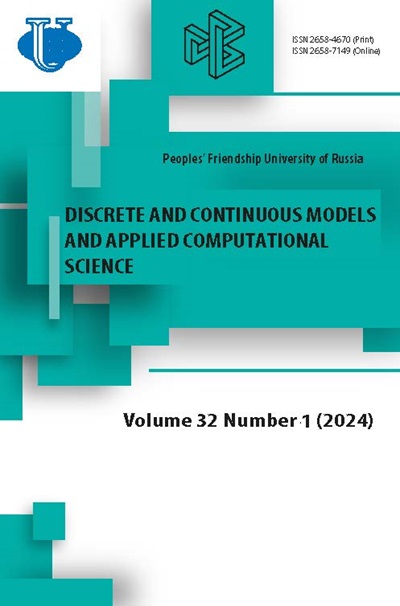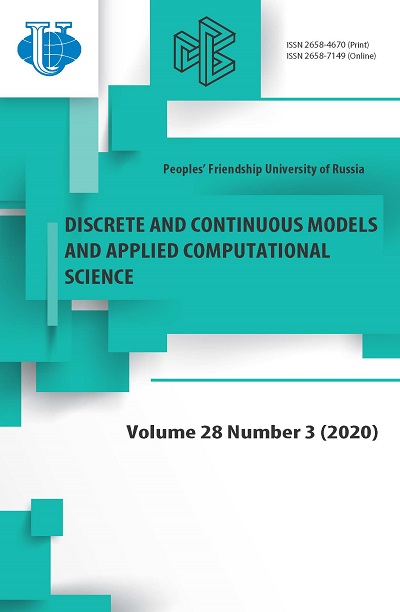Асимптотический метод построения модели адиабатических волноводных мод плавно-нерегулярных интегрально-оптических волноводов
- Авторы: Севастьянов А.Л.1
-
Учреждения:
- Российский университет дружбы народов
- Выпуск: Том 28, № 3 (2020)
- Страницы: 252-273
- Раздел: Статьи
- URL: https://journals.rudn.ru/miph/article/view/24705
- DOI: https://doi.org/10.22363/2658-4670-2020-28-3-252-273
Цитировать
Полный текст
Аннотация
В работе рассмотрен класс плавно нерегулярных интегрально-оптических многослойных волноводов, свойства которых определяют характерные черты волноводного распространения в них монохроматического поляризованного света. Предложен асимптотический подход к описанию данного вида электромагнитного излучения, в результате которого решения системы уравнений Максвелла редуцируется к такому виду, который выражается через решения системы четырёх обыкновенных дифференциальных уравнений и двух алгебраических уравнений для шести компонент электромагнитного поля в нулевом приближении. Градиент фазового фронта адиабатической волноводной моды удовлетворяет уравнению эйконала относительно эффективного показателя преломления волновода относительно данной моды.Многослойная структура волноводов позволяет произвести ещё один этап редукции системы уравнений модели к однородной системе линейных алгебраических уравнений, условие нетривиальной разрешимости которой задаёт связь градиента фазового фронта излучения с градиентами поверхностей раздела между тонкими однородными слоями.В завершающей части работы сформулированы задачи (дифференциальная и алгебраическая) на собственные значения и собственные векторы для описания адиабатических волноводных мод. Приведена также формулировка задачи описания одномодового режима распространения адиабатических волноводных мод, подчёркивающая адиабатический характер описываемого приближенного решения уравнений Максвелла.
Об авторах
А. Л. Севастьянов
Российский университет дружбы народов
Автор, ответственный за переписку.
Email: sevastianov-al@rudn.ru
Candidate of Physical and Mathematical Sciences, assistant professor of Department of Applied Probability and Informatics
ул. Миклухо-Маклая, д. 6, Москва, 117198, РоссияСписок литературы
- A. A. Samarskii and A. N. Tikhonov, “Representation of the field in a waveguide as the sum of the TE and TM fields [O predstavlenii polya v volnovode v vide summy polej TE i TM],” Zhurnal tekhnicheskoy fiziki, vol. 18, no. 7, pp. 959-970, 1948, in Russian.
- A. G. Sveshnikov, “A substantiation of a method for computing the propagation of electromagnetic oscillations in irregular waveguides,” USSR Computational Mathematics and Mathematical Physics, vol. 3, no. 2, pp. 413-429, 1963. doi: 10.1016/0041-5553(63)90027-2.
- V. V. Shevchenko, “Spectral decomposition in eigenand associated functions of a nonselfadjoint problem of Sturm-Liouville type on the entire axis [O spektral’nom razlozhenii po sobstvennym i prisoedinennym funkciyam odnoj nesamosopryazhennoj zadachi tipa SHturma-Liuvillya na vsej osi],” Differ. Uravn., vol. 15, no. 11, pp. 2004-2020, 1979, in Russian.
- L. N. Deryugin, A. N. Marchuk, and V. E. Sotin, “Properties of planar asymmetrical dielectric waveguides on a substrate of dielectric [Svojstva planarnogo asimmetrichnogo dielektricheskogo volnovoda na podlozhke iz dielektrika],” Izv. Vyssh. Uchebn. Zaved., Ser. Radioelektron., vol. 10, no. 2, pp. 134-141, 1967, in Russian.
- A. G. Sveshnikov, “The incomplete Galerkin method [Nepolnyj metod Galerkina],” Dokl. Akad. Nauk SSSR, vol. 236, no. 5, pp. 1076-1079, 1977, in Russian.
- A. A. Bykov, A. G. Sveshnikov, and M. K. Trubetskov, “Reduced Galerkin’s method application to calculations of eigenwaves in open waveguides [Primenenie nepolnogo metoda Galerkina dlya rascheta sobstvennyh voln otkrytyh volnovodov],” Matem. Mod., vol. 3, no. 7, pp. 111-123, 1991, in Russian.
- B. Z. Katsenelenbaum, Theory of Irregular Waveguides with Slowly Varying Parameters [Teoriya neregulyarnyh volnovodov s medlenno menyayushchimisya parametrami]. Moscow: Akad. Nauk SSSR, 1961, in Russian.
- V. V. Shevchenko, Continuous Transitions in Open Waveguides [Plavnye perekhody v otkrytyh volnovodah]. Moscow: Nauka, 1969, in Russian.
- L. A. Sevastianov and A. A. Egorov, “Theoretical analysis of the waveguide propagation of electromagnetic waves in dielectric smoothly-irregular integrated structures,” Optics and Spectroscopy, vol. 105, no. 4, pp. 576-584, 2008. doi: 10.1134/S0030400X08100123.
- A. A. Egorov and L. A. Sevastianov, “Structure of modes of a smoothly irregular integrated optical four-layer three-dimensional waveguide,” Quantum Electronics, vol. 39, no. 6, pp. 566-574, 2009. doi: 10.1070/QE2009v039n06ABEH013966.
- A. A. Egorov, K. P. Lovetskiy, A. L. Sevastianov, and L. A. Sevastianov, “Simulation of guided modes (eigenmodes) and synthesis of a thin-film generalised waveguide Luneburg lens in the zero-order vector approximation,” Quantum Electronics, vol. 40, no. 9, pp. 830-836, 2010. doi: 10.1070/QE2010V040N09ABEH014332.
- A. A. Egorov, A. L. Sevast’yanov, and L. A. Sevast’yanov, “Stable computer modeling of thin-film generalized waveguide Luneburg lens,” Quantum Electronics, vol. 44, no. 2, pp. 167-173, 2014. DOI: 10.1070/ QE2014v044n02ABEH015303.
- A. A. Egorov, A. L. Sevastyanov, E. A. Ayryan, and L. A. Sevastyanov, “Stable computer modeling of thin-film generalized waveguide Luneburg lens [Ustojchivoe komp’yuternoe modelirovanie tonkoplenochnoj obobshchennoj volnovodnoj linzy Lyuneberga],” Matem. Mod., vol. 26, no. 11, pp. 37-44, 2014, in Russian.
- A. S. Il’inskii, V. V. Kravtsov, and A. G. Sveshnikov, Mathematical Models of Electrodynamics [Matematicheskie modeli elektrodinamiki]. Moscow: Vyssh. Shkola, 1991, in Russian.
- M. J. Adams, An Introduction to Optical Waveguides. New York: Wiley, 1981.
- T. Tamir, “Guided-Wave Optoelectronics,” in Integrated Optics, T. Tamir, Ed. Berlin: Springer-Verlag, 1990.
- A. W. Snyder and J. D. Love, Optical Waveguide Theory. New York: Chapman and Hall, 1983.
- D. Markuze, Theory of Dielectric Optical Waveguides. New York: Academic Press, 1974.
- M. Barnoski, Introduction to Integrated Optics. New York: Plenum Press, 1974.
- A. I. Neishtadt, “On the accuracy of conservation of the adiabatic invariant,” Journal of Applied Mathematics and Mechanics, vol. 45, no. 1, pp. 58-63, 1981. doi: 10.1016/0021-8928(81)90010-1.
- I. V. Gorelyshev and A. I. Neishtadt, “On the adiabatic perturbation theory for systems with impacts,” Journal of Applied Mathematics and Mechanics, vol. 70, no. 1, pp. 4-17, 2006. doi: 10.1016/j.jappmathmech.2006.03.015.
- V. M. Babich and V. S. Buldyrev, Asymptotic Methods in ShortWavelength Diffraction Theory, Alpha Science Series on Wave Phenomena. Harrow, UK: Alpha Science International, 2009.
- Y. A. Kravtsov and Y. I. Orlov, Geometrical Optics of Inhomogeneous Media. Berlin: Springer-Verlag, 1990.
- B. Z. Katsenelenbaum, “Irregular waveguides with slowly varying parameters [Neregulyarnye volnovody s medlenno menyayushchimisya parametrami],” Doklady Akademii Nauk SSSR, vol. 102, no. 4, p. 711, 1955, in Russian.
- B. Z. Katsenelenbaum, “A contribution to the general theory of nonregular wave guides [K obshchej teorii neregulyarnyh volnovodov],” Dokl. Akad. Nauk SSSR, vol. 116, no. 2, pp. 203-206, 1957, in Russian.
- A. I. Neishtadt, “Propagation of rays in smoothly irregular waveguides and perturbation theory of Hamiltonian systems [Rasprostranenie luchej v plavno neregulyarnyh volnovodah i teoriya vozmushchenij gamil’tonovyh sistem],” Izv. vuzov. Radiofizika, vol. 25, no. 2, pp. 218- 226, 1982, in Russian.
- A. L. Sevastyanov, “Single-mode waveguide spread of light in a smooth irregular integral optical waveguide [Komp’yuternoe modelirovanie polej napravlyaemyh mod tonkoplenochnoj obobshchennoj volnovodnoj linzy Lyuneberga],” in Russian, Ph.D. dissertation, Peoples’ Friendship University of Russia, Moscow, 2010.
- S. Solimeno, B. Crosignani, and P. DiPorto, Guiding, Diffraction, and Confinement of Optical Radiation. Orlando, FL: Academic Press, 1986.
- M. Kline and I. W. Kay, Electromagnenic Theory and Geometricak Optics. New York: Wiley (Inter-science), 1965.
- M. V. Fedoryuk, “A justification of the method of transverse sections for an acoustic wave guide with nonhomogeneous content,” Mathematical Physics, vol. 13, no. 1, pp. 162-173, 1973. doi: 10.1016/0041-5553(74) 90012-3.
















